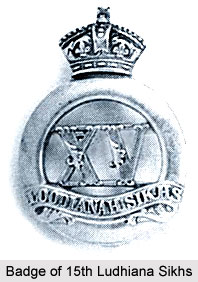 The 15th Regiment of Bengal Native Infantry (Ludhiana Sikhs), also known as 15th Ludhiana Sikhs, was an erstwhile regiment of foot soldiers raised by the British East India Company. The unit was a part of the Bengal Native Infantry and operated under the Bengal Army of Bengal Presidency till 1895. The Army of Bengal Province was one of the 3 chief Presidency Armies in British India. The infantry unit was founded in the year 1846. It remained in active service till the year 1922. The 15th Ludhiana Sikhs were also a division of the Bengal Command. King Edward VII acted as the Colonel-in-Chief of the unit in 1904. After the Indian independence, the unit became a part of the Indian Army as part of the tripartite agreement.
The 15th Regiment of Bengal Native Infantry (Ludhiana Sikhs), also known as 15th Ludhiana Sikhs, was an erstwhile regiment of foot soldiers raised by the British East India Company. The unit was a part of the Bengal Native Infantry and operated under the Bengal Army of Bengal Presidency till 1895. The Army of Bengal Province was one of the 3 chief Presidency Armies in British India. The infantry unit was founded in the year 1846. It remained in active service till the year 1922. The 15th Ludhiana Sikhs were also a division of the Bengal Command. King Edward VII acted as the Colonel-in-Chief of the unit in 1904. After the Indian independence, the unit became a part of the Indian Army as part of the tripartite agreement.
History of 15th Regiment of Bengal Native Infantry (Ludhiana Sikhs)
The 15th Regiment of Bengal Native Infantry (Ludhiana Sikhs) was formed as the Regiment of Ludhiana in 1846. During the outbreak of the Sepoy Mutiny in 1857, the troops were appointed to guard the region of Benares now Varanasi. Later in the year 1861, the unit was designated as the 15th Bengal Native Infantry. In 1864, it was again re-named as the 15th (Ludhiana) Regiment of Bengal Native Infantry. After the Kitchener reforms in the British Indian Army in 1903, the regiment was re-designated as the 15th Ludhiana Sikhs. In 1905, the battalion participated in the Rawalpindi Parade to celebrate the visit of the Prince and Princess of Wales to India.
Military Operations of 15th Regiment of Bengal Native Infantry (Ludhiana Sikhs)
The 15th Regiment of Bengal Native Infantry (Ludhiana Sikhs) fought in the Battle of Kandahar and the Battle of Ahmed Khel during the Second Anglo Afghan War. The troops later took part in the Battle of Suakin and Tofrek during the Mahdist War. The unit also fought in China and the Punjab Frontier and participated in the Tirah Campaign, the Chitral Expedition and the First World War. The regiment was merged with the Jullundur Brigade, 3rd (Lahore) Division during the World War I. It was stationed on the Western Front in France and later became part of the Western Frontier Force and served in Egypt and the Mesopotamia Campaign.
Development of 15th Regiment of Bengal Native Infantry (Ludhiana Sikhs)
When the First World War ended, the British Government of India re-established the army. All the single battalion infantry units were merged to raise multi battalion regiments consisting of 4 to 6 battalions each. In 1922, the 15th Regiment of Bengal Native Infantry was renamed as the 2nd Battalion, 11th Sikh Regiment.
After the nation achieved freedom on 15th August 1947, the Union of India and the Dominion of Pakistan was formed through the Partition of India. As a result, the regiments of British Indian Army were divided among India and Pakistan. The 15th Ludhiana Sikhs unit was assigned to the modern Indian Army as part of the Tripartite Agreement between India, Britain and Nepal.
Designations of 15th Regiment of Bengal Native Infantry (Ludhiana Sikhs)
The different titles held by the 15th Regiment of Bengal Native Infantry (Ludhiana Sikhs) is listed below-
* Regiment of Ludhiana in 1846
* 15th Bengal Native Infantry in 1861
* 15th (Ludhiana) Regiment of Bengal Native Infantry in 1864
* 15th Regiment of Bengal Native Infantry (Ludhiana Sikhs) in 1885
* 15th (Ludhiana) Sikh Infantry in 1901
* 15th Ludhiana Sikhs in 1903
* 2nd Battalion, 11th Sikh Regiment in 1922



















